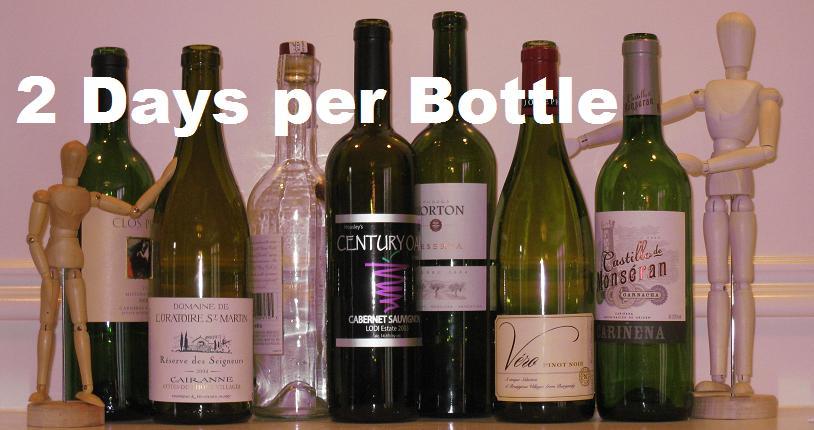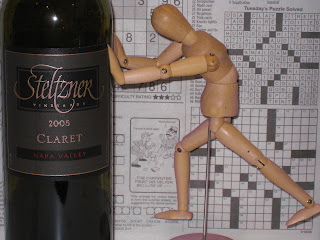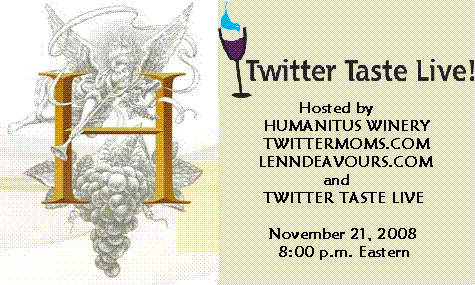Why do people write wine review blogs? That is an interesting question, and it needs to broken down a bit.
First, why do people wine blog? There are as many reasons as there are bloggers, but they all come down to pretty much the same thing. They love wine, and today you blog what you love. It makes you feel a little closer, it gets you more involved, it makes you part of a community with the same interest, and it allows you to share your love with others. Of course, some people blog as part of a business, wineries, retailers, marketers, etc., but even they are doing something they love and joining a community of others that feel the same way.
Second, why do wine bloggers write wine review blogs? That's a slightly different story. There are lots of wine blogs out there that are not wine review blogs. Fermentation: The Daily Wine Blog does not review wine at all. It blogs the wine business, and particularly the conflict between wine lovers and wine distributors (along with lots of other interesting things). The Wine Connoisseur blogs the news about wine. Dr. Vino does some reviews, but blogs the wine industry in depth as well. Then there are the straight review blogs. Good Wine Under $20 focuses on wines at a reasonable price. Wannabe Wino reviews what she drinks, often from winery trips. There are so many out there I can't do justice to them all. What they all have in common, though, is that they love wine, and they share that love with you, the reader.
That is what we do for ourselves. What do we do for the reader? We provide, I hope, a service. When I look at statistics from my own site I find that more than half my views come from wine searches. People type "Villa Maria" or "Rockaway" into the little Google box, looking for reviews. What do they find? If they come to my blog, they find positive AND negative reviews. If they go to other blogs they might only find positive ones. Are we doing those consumers a service if we do not warn them away from garbage? In my opinion, no. So why do some people only write positive reviews? Good question. Let's ask them.
From the tremendous and well-respected Vinography, Is there any point to negative wine reviews?
1. There was so much mediocre wine out there in the world that lukewarm or negative reviews could easily take up the majority of my writing time.
2. Writing negative reviews is about as fun as completing the writing comprehension section of the SAT.
3. People mostly want to know which wines are great much more than they want to know which wines to avoid.
and
a. Many times, I don't necessarily know that the bottle I happen to be reviewing isn't simply just a bit off -- whether from a fault that I am not detecting or identifying or simply due to bottle variation of some sort or another.
b. A bad review is quite damaging, because it is often read as a condemnation of the winery itself (despite any care or attention put to the contrary by the author) even though the particular wine in question could be part of a portfolio of truly stellar wines.
c. Likewise, bad reviews are often read (and written by irresponsible critics) as being absolute and categorical judgements about a winery, when in fact they are mere evaluations of a specific wine in a specific vintage. That particular wine could have been great the year before, or it could get great the next year. But bad reviews hang around in the minds of consumers like skeletons in the closet, much longer than they should.
d. Bad reviews also hang around in the minds of winemakers and winery owners a lot longer than they should. Like it or not, anyone who seriously attempts to write consistently about wine in a critical fashion has a symbiotic (or as Jancis Robinson would put it, a parasitic) relationship with the wine industry. Bad reviews burn bridges in ways that make it difficult for the writer to ply their craft.
Are these good reasons? In my own opinion, not at all. I am not alone, either. The very first person to comment in response asked:
What if you substituted "a good review" in the points above (a,b,c, and d)-does your logic also follow through (in the opposite direction) on these wineries?
Yup.
Now let's break that down a bit more, okay?
1. There was so much mediocre wine out there in the world that lukewarm or negative reviews could easily take up the majority of my writing time.
Really? Do you really drink that much bad wine? Why? I expect most bloggers are fairly discriminating about what they purchase. Do I get bad wine? Absolutely. But is it the norm? Nope. I generally don't buy something awful, and since I promise to write good AND bad reviews, people don't often send less than their best efforts.
2. Writing negative reviews is about as fun as completing the writing comprehension section of the SAT.
I respectfully disagree. In fact, I don't think I ever had more fun writing a review than when I channeled Dr. Suess and wrote a haiku for Deerfield Merlot Cuvee.
3. People mostly want to know which wines are great much more than they want to know which wines to avoid.
Upon what do you base this conclusion? I look at my statistics and find that people search bad wine as often as they search good wine.
a. Many times, I don't necessarily know that the bottle I happen to be reviewing isn't simply just a bit off -- whether from a fault that I am not detecting or identifying or simply due to bottle variation of some sort or another.
While this is true, it is equally true that the next sucker could end up with a bottle just as bad. Also, there is a huge difference between "this might be a bit flawed" or "it ain't great" and "oh man is this awful overworked over-alcoholed manufactured oak powdered crap."
b. A bad review is quite damaging, because it is often read as a condemnation of the winery itself (despite any care or attention put to the contrary by the author) even though the particular wine in question could be part of a portfolio of truly stellar wines.
Is a good review praising a winery itself, even if they have bad stuff in their portfolio? Also, isn't this best handled by the review? You don't just write "good" or "bad." You write a review, right?
c. Likewise, bad reviews are often read (and written by irresponsible critics) as being absolute and categorical judgements about a winery, when in fact they are mere evaluations of a specific wine in a specific vintage. That particular wine could have been great the year before, or it could get great the next year. But bad reviews hang around in the minds of consumers like skeletons in the closet, much longer than they should.
See (b), supra.
d. Bad reviews also hang around in the minds of winemakers and winery owners a lot longer than they should. Like it or not, anyone who seriously attempts to write consistently about wine in a critical fashion has a symbiotic (or as Jancis Robinson would put it, a parasitic) relationship with the wine industry. Bad reviews burn bridges in ways that make it difficult for the writer to ply their craft.
This is, by far, the worst reason not to write bad reviews. If you fear the wineries' reaction, then you are being bullied into the very parisitic relationship described by Robinson. If you accept that, even applaud it, then you have a credibility problem. Worse, if enough people do the same, then your credibility problem bleeds into the entire wine-writing blogosphere.
Other very well-known and well-respected wine bloggers also write only positive reviews, like Another Wine Blog:
Anyway, when a wine is reviewed on this site it is because we enjoyed it and we want to share that information with our readers. It is that simple. It does not make one bit of difference if a friend gave it to us as a gift, or if it came from one of our wine clubs, if it came from the grocery store, or if a wine industry person sent it to be reviewed, the review will be positive and it will be honest. Does anyone really want to hear about the Franzia that was served at some reception? Or the crap bottle the local wine megastore lackey conned me into buying because he is an idiot and ordered too much of it? I may write about the megastore or the lackey, but who cares about the bad wine? Besides, someone might like that wine. My palate is not omniscient, despite a drunken boast or two I may have made to the contrary.
Hey, wait a minute. I already know about the Franzia, but I sure want to know about the crap bottle before my own local wine megastore lackey cons me into buying the same thing. As for your palate, well, doesn't the same conversation go the same way for wine you like? Also, it is not just a matter your palate, unless all you write is "good" or "bad." If, on the other hand, you explain WHY you didn't like it- over-extracted, too hot, too sweet, out of character for the grape, etc., then people can judge for themselves whether to follow your recommendation.
Stop thinking about "wine review" for a minute and think about "review." A movie, two tickets, sodas and snacks, costs a fair chunk of change these days. Do you read movie reviews before you go? I do. Not just that, but I consider a poor review a favor. It is not just the reviewer's conclusion that matters, but the content as well. If a movie reviewer writes "this was not a good movie because it was poorly edited, jumped from unconnected scene to unconnected scene, and substituted gore and violence for a coherent story," I am going to take a pass. On the other hand, if it says "this was not a good movie because it had far too much gratuitous starlet nudity, but otherwise held together well," well, I'm going. Twice. See how that works? As wine writers, we WRITE, not merely opine.
Movies give us another more concrete lesson, too. Do you remember David Manning? He was a fictitious film critic created by Sony to create poster quotes. Sony ended up paying out $1.5M in settlement for that fraud. I am not equating positive-review-only bloggers with "David Manning." I do suggest, however, that positive-review-only blogs will hurt our credibility. People will start to wonder "is this another David Manning?"
Look again at your statistics. If a potential consumer Googles "Chateau Perfection" they will find it. But what if they Google "Chateau Plonque"? You know it's crap. You know it's Sahara meets Gigli, yet you leave them to discover that on their own.
Now add one more factor, free wine. Is there an added responsibility to write negative reviews if you are getting free samples? Or is that just cutting off your hand to spite your face, a guaranteed path to making the UPS guy a stranger, to a life of having to buy all your own wine? The answer, to me, is both. Yes, you risk missing out on freebies if the winemakers have a more "friendly" set of bloggers they can count on to laud the good stuff and bury the bad. At that point, though, you are a free PR arm of the winery. You might not be "David Manning," but are you getting too close? Are you at least Larry King, notorious as the softest interview in politics, instead of being Meet the Press?
What is the bottom line to all this? The blogosphere is still new, and the wine blogosphere newer still. We are still feeling out our place in the world. In my own very personal opinion, writing only positive reviews might score you a few more free bottles, but your free bottles might cost my credibility. It might also do a disservice to the next consumer with the bad luck to run into that wine megastore lackey.
One commenter in a related thread observed that my reasoning means I have to review every sample I receive. He's right. I do. See my wine review policy at the top of the right hand colum. I don't do it on anybody's schedule, but I do it. Do you?

































